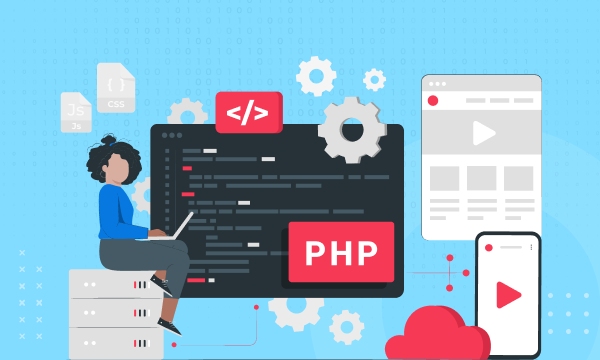What is PHP
PHP, is a super popular and widely used server-side scripting language designed specifically for web development. PHP powers about 78% off all websites, it is known for its simplicity, versatility, and wide adoption across the web. It is normally embedded within HTML code and executed on the server, generating dynamic web pages that can interact with databases, handle form submissions, and perform various other tasks.
PHP is primarily used to build dynamic websites and web applications. Its key features make it suitable for a range of web development tasks, including:
Key Features:
Server-side scripting
PHP scripts are executed on the web server, generating HTML that is then sent to the client’s browser. This allows PHP to perform complex processing tasks and database interactions before presenting the final output.
Database integration
PHP has robust support for connecting to databases such as MySQL, PostgreSQL, and SQLite. It enables developers to retrieve data from databases, insert new data, update existing records, and perform other database-related operations.
Form handling
PHP simplifies the processing of user input from web forms. It can capture form data, validate it, and store it in a database or send it via email. PHP also facilitates handling file uploads, manipulating data, and generating form validation and error messages.
Dynamic content generation
PHP makes it easy to generate dynamic content on web pages. It enables developers to embed variables, conditionally display content, loop through data, and create reusable functions to streamline web development.
Session management
PHP provides session management capabilities, allowing you to create and manage user sessions. Sessions enable you to store user-specific data across multiple page requests, providing a way to maintain state and personalize user experiences.
Integration with other technologies
PHP integrates well with other web technologies such as HTML, CSS, JavaScript, and various web frameworks like WordPress, Laravel, and Symfony. It can be used in conjunction with front-end frameworks to create powerful, feature-rich web applications.
PHP’s wide usage and extensive community support have resulted in a vast ecosystem of libraries, frameworks, and resources that make web development more efficient and productive. It is favored by both beginners and experienced developers due to its gentle learning curve and versatility.
In summary, PHP is a server-side scripting language that allows developers to build dynamic web pages and web applications. With its ability to interact with databases, handle form submissions, and generate dynamic content, PHP remains a popular choice for web development.
Here’s a beginner’s guide to the basics of PHP:
Setting Up PHP
To get started with PHP, you need to have a web server (such as Apache), PHP installed on your server, and a code editor for writing PHP code. Follow the installation instructions for your specific operating system to set up PHP.
PHP Syntax
PHP code is embedded within HTML files using special delimiters: ?php` and `?>. Any code within these delimiters will be interpreted and executed by the PHP engine. For example:
Variables and Data Types
Variables in PHP are represented with a dollar sign `$` followed by the variable name. PHP supports various data types, including strings, integers, floats, booleans, arrays, and more. Variables do not require explicit type declaration. Here’s an example:
Outputting Data
You can output data to the browser using the `echo` or `print` statements. These statements display text or the value of variables. For example:
Conditional Statements
PHP provides conditional statements to make decisions in your code. The most commonly used conditional statements are `if`, `else if`, and `else`. They allow you to execute different blocks of code based on certain conditions. Here’s an example:
Loops
Loops enable repetitive execution of a block of code. PHP supports different types of loops, including `for`, `while`, and `foreach`. These loops allow you to iterate over arrays, perform a specific number of iterations, or execute code until a condition is met. Here’s an example:
Functions
Functions allow you to group a set of statements together and execute them when needed. They provide code reusability and help organize your codebase. You can define functions and call them throughout your code. Here’s an example:
Working with Forms
PHP is often used to process form data submitted by users. When a form is submitted, PHP can capture the values of the form elements using the $_POST or $_GET superglobal arrays. Here’s a basic example:
Database Interaction
PHP can interact with databases to store and retrieve data. The most common method is using the PDO (PHP Data Objects) extension, which supports multiple database types. You can establish a database connection, execute queries, and fetch results. Here’s a basic example:
This guide provides a basic introduction to PHP, covering key concepts and syntax. As you continue learning, you can explore more advanced topics such as object-oriented programming, sessions, error handling, and security considerations. The PHP documentation (php.net) is an excellent resource for further exploration and learning.
